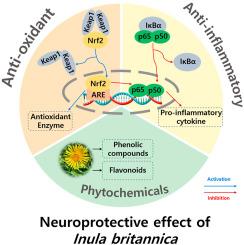英菊通过Nrf2-Keap1信号通路对SH-SY5Y细胞发挥抗氧化和抗炎作用
IF 3
3区 生物学
Q2 BIOCHEMISTRY & MOLECULAR BIOLOGY
引用次数: 0
摘要
菊科的黄花,英菊(IB)自古以来就被用作草药。现代研究已广泛了解IB的抗炎和抗氧化作用,因此本研究旨在分析IB提取物在抗氧化和抗炎作用的基础上的神经保护作用,并评估其作为功能材料的开发潜力。以水和70%乙醇(EtOH)为溶剂制备IB提取物,对其植物化学成分进行鉴定。采用逆转录聚合酶链反应和western blotting检测IB提取物对h2o2诱导SH-SY5Y细胞Nrf2-Keap1信号通路、NF-κB信号通路及Bax/Bcl-2比值的影响。两种IB提取物均以浓度依赖的方式激活具有代表性的抗氧化信号通路Nrf2-Keap1。在炎症相关的NF-κB信号通路中,IB提取物抑制了各因子的表达,降低了与凋亡相关的Bax/Bcl-2比值。通过液相色谱-串联质谱分析,发现其主要活性成分为多酚类化合物和黄酮类化合物,提示其提取物具有治疗神经退行性疾病的功能物质潜力。本文章由计算机程序翻译,如有差异,请以英文原文为准。

Inula britannica exerts antioxidant and anti-inflammatory effects in SH-SY5Y cells through the Nrf2–Keap1 signaling pathway
The yellow flower of the Asteraceae family, Inula britannica (IB) of have been used as a medicinal herb since ancient times. Modern studies have widely known the anti-inflammatory effects and antioxidant effects of IB. Therefore, this study aimed to analyze the neuroprotective effects of IB extract based on its antioxidant and anti-inflammatory effects and to assess its potential for development as a functional material. After preparing the extract of IB based on the solvent with water and 70 % ethyl alcohol (EtOH), the phytochemical components were identified. The effects of the IB extracts on the Nrf2–Keap1 signaling pathway, NF-κB signaling pathway, and Bax/Bcl-2 ratio were investigated in H2O2-induced SH-SY5Y cells using reverse transcription-polymerase chain reaction and western blotting. Both IB extracts activated the representative antioxidant signaling pathway Nrf2–Keap1 in a concentration-dependent manner. In the inflammation-related NF-κB signaling pathway, the expression of each factor was inhibited, and the Bax/Bcl-2 ratio, which is related to apoptosis, decreased upon IB extract treatment. Phytochemical analysis using liquid chromatography-tandem mass spectrometry identified polyphenols and flavonoids as the primary active compounds in IB. These findings indicate that IB extract has potential as a functional material for the treatment of neurodegenerative diseases.
求助全文
通过发布文献求助,成功后即可免费获取论文全文。
去求助
来源期刊

Archives of biochemistry and biophysics
生物-生化与分子生物学
CiteScore
7.40
自引率
0.00%
发文量
245
审稿时长
26 days
期刊介绍:
Archives of Biochemistry and Biophysics publishes quality original articles and reviews in the developing areas of biochemistry and biophysics.
Research Areas Include:
• Enzyme and protein structure, function, regulation. Folding, turnover, and post-translational processing
• Biological oxidations, free radical reactions, redox signaling, oxygenases, P450 reactions
• Signal transduction, receptors, membrane transport, intracellular signals. Cellular and integrated metabolism.
 求助内容:
求助内容: 应助结果提醒方式:
应助结果提醒方式:


